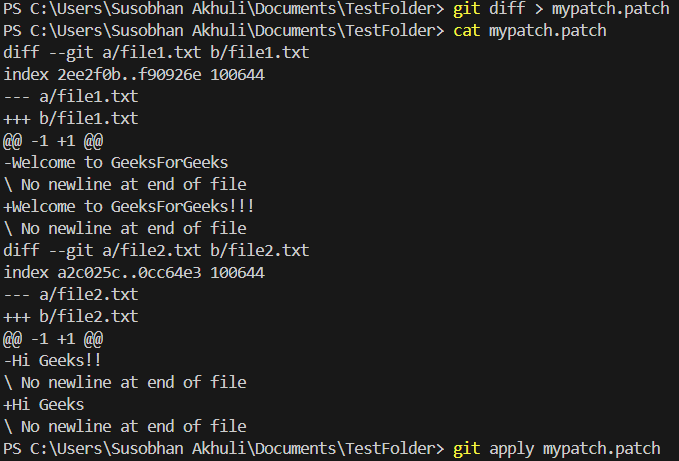|
Creating a Git patch from uncommitted changes is a handy way to share your code changes without committing them. It’s useful for code reviews, collaboration, and backups. A Git patch captures the differences between your working directory and the repository, and you can apply it later to another branch or repository. In this article, we’ll walk through how to create a Git patch from uncommitted changes in your current working directory.
What is a Git Patch?
A Git patch is a file that contains changes made to a codebase, including additions, deletions, and modifications. It can be applied to other branches or repositories to replicate the changes. Patches are typically used for:
- Sharing changes with team members.
- Submitting changes for code review.
- Creating backups of your changes.
- Applying changes to different branches or repositories.
Why Create a Git Patch from Uncommitted Changes?
- Share Without Committing: Share your changes without committing them to the repository.
- Review Changes: Send changes for review before committing.
- Collaborate Efficiently: Collaborate with others who can apply the patch to their local repositories.
- Backup Changes: Create a backup of your changes that can be applied later.
Method 1: Using git diff
The git diff command is used to generate a patch file that captures the differences between your working directory and the last commit. This method is suitable for creating patches from uncommitted changes, whether they are staged or unstaged.
Step 1: Make some changes to files in your repository.
Step 2: Stage specific changes using git add (Optional)
git add file1.txt file2.txt
Step 3: Generate the patch file
git diff > mypatch.patch
Step 4: Inspect the patch file to verify its contents
cat mypatch.patch
Step 5: Share the patch file or apply it using git apply
git apply mypatch.patch
Output:
 Output using git diff Note: The .patch file will be stored into the working folder.
The git format-patch command is used to create a series of patch files from a range of commits. This method is generally used for committed changes, but it can be adapted for uncommitted changes by creating a temporary commit.
Step 1: Make some changes to files in your repository.
Step 2: Stage the changes you want to include in the patch
git add file1.txt file2.txt
Step 3: Identify the commit to diff against (replace HEAD with the desired commit hash if needed)
git log --oneline
Step 4: Generate the patch file
git diff --cached HEAD | git format-patch -1 --stdout > mypatch.patch
Step 5: Inspect the patch file to verify its contents
cat mypatch.patch
Step 6: Share the patch file or apply it using git 'am‘
git am mypatch.patch
Output:
 Output using git format-patch Note: The .patch file will be stored into the working folder.
Conclusion
Creating Git patches from uncommitted changes is a valuable skill for collaboration and code management. By following these approaches, we can effectively share, review, and manage changes before committing them to our repository.
|

